
From the author's personal collection Winners and Losers: Plant Regimes in Flux TOM WALKER Back in 1920, when the picture was taken, the new Mount McKinley National Park boasted huge herds of Dall sheep and plentiful caribou. Severe winter weather in 1928 and again in 1932 killed hundreds of sheep. Despite complete protection, the sheep herds never rebounded to their former abundance; the Denali caribou herd is a fraction of its peak number. My view is that sheep and caribou will never again reach their historic highs — changes in habitat, the result of global warming, an important reason.
Mountain sheep fascinate me. I have studied and photographed them all over North America, from desert slopes to arctic peaks. Dall sheep are my favorite and I have spent much time in their alpine world. Their range here in Denali — characterized by Dryas (Mountain Avens) and other low-growing plants — has been morphing over my four decades of personal observation. For one thing, some areas are much drier now and the vegetation different from what I first encountered there on the ridges and high meadows. Warmer temperatures and slightly longer growing seasons have allowed woody plants to spread into the alpine. In the places where I regularly hike, the encroachment of alders on the fringes of the alpine is widespread. During summer months, sheep consume a wide variety of plants but in winter their diet is narrowed to dry, frozen grass and sedge stems found on slopes and ridges blown free of snow. In these limited winter ranges, any loss of these forage plants poses a serious risk to sheep survival. Mid-winter thaws and rains, which occur more frequently now than in the past, prevent, or limit, sheep from obtaining their food. Unusually deep snows, and ice-armored slopes, were the precise causes of the catastrophic crash of the park’s Dall sheep population decades ago.
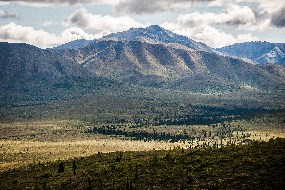
NPS Photo by Kent Miller Other sections of the park, which were once open tundra, also have been transformed by vigorous plant growth. Slopes once covered by ankle-high plants are now shin-tangles of dwarf birch. Woody plants tend to crowd out other species important to grazers, like sheep and caribou. Lichens are a critical forage item for wintering caribou. A composite organism made up of algae and fungus, lichens are considered to be among the oldest living things on earth. These plants are hardy but when dried out are quite delicate, easily damaged by hikers, or even passing caribou. Since they have no roots and extract water from the air, lichens are sensitive to ozone depletion, air and chemical pollution such as acid rain, and nuclear fallout. Because lichens are long-lived they tend to concentrate contaminants. The lingering effects from atmospheric nuclear testing and industrial pollution in Eastern Europe have been identified throughout the circumpolar Arctic. Much of the park is wilderness, some of it inaccessible, yet nonetheless vulnerable to industrial residues created halfway around the world. Shifting weather patterns no doubt will only worsen the problem. Alterations in dominant plant communities will challenge the animals that have adapted over the centuries to the tundra and alpine regions. What will happen to caribou, for example, as tundra plants shift in response to oscillating weather patterns and warming temperatures? In 2009, due to construction of the new Mountain Vista Rest Area, the Park Road remained open into November, later than any year since the early 1980’s. The open road gave me the opportunity to explore a portion of the park usually beyond walking distance in early winter. Despite temperatures dipping to minus 20, I wandered the drainages from Mile 9 to Mile 13 in search of moose. The willow flats south of Mile 10 used to be my favorite place to watch and photograph moose. I found the terrain transformed. Just in the last 10 years or so, woody plants have surged and grown from knee-high on a moose to chest-high, taller in some places. For example, I saw a cow moose crossing what was once an open glade but is now choked with dwarf birch and scattered spruce. Two small ponds near there used to be favored watering holes for moose. In the last ten years, both have dried up and transmuted into grassy meadows. Despite periods of record rain in 2014, the ponds never filled up. I suspect that the underlying ice that once held the water at the surface has melted, allowing runoff and rain to quickly percolate below ground. An iconic Denali Park image is of a moose feeding in Wonder Lake with Mount McKinley in the background. The moose are after pondweed (Elodea canadensis), a favored part of their diet. Aquatic plants are not immune to warming temperatures and unpredictable water levels. On the east end of the park I have seen places where tall reeds (likely sedges) are crowding out the pondweed. In one of them, these reeds have altered the plant regime to the degree that moose seldom feed there anymore. Clearly, these plants have replaced the pondweed, to the detriment of moose. 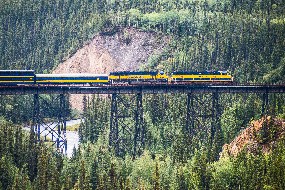
NPS Photo by Kent Miller Back in the late 1960’s I heard Adolph Murie describe the area around the Alaska Railroad depot as “the finest moose calving grounds in all of Alaska.” A wildfire in 1924, likely caused by sparks from a railroad engine, scorched an estimated 35 square miles in the surrounding area. The fire burned well up the hillsides, and at one point threatened the original park headquarters on Riley Creek. Summer rains eventually extinguished the flames. Murie’s comment was an acknowledgment of the role wildfire plays in the creation of moose habitat.
Charred stumps and downed timber still litter the ground, stark evidence of that uncontrolled fire. As a historian I have looked at numerous photographs from that period and am always amazed by the differences then and now. Even before the fire, the land was more open with few stands of mature timber. The fire opened it even more, destroying most of the spruce, and enabling the spread of deciduous trees. Every autumn, when the slopes by Riley Creek and above Montana Creek are covered in brilliant yellow aspens, I am reminded that the colorful display is the result of wildfire.
Large fires are a normal feature of the forest ecosystem in Interior Alaska. The severity of the fire season varies dramatically based on weather and climatic variations. In the record year of 1956, fire consumed five million acres of forest in central Alaska. Not infrequently, dense smoke from distant forest fires chokes the summer air here, obscuring the vistas and peaks.
Summers in Interior Alaska are typically hot and dry, perfect for the development of numerous thunderstorms. Consequently most fires are lightning-caused. Alaska averages about 32,000 individual lightning strikes annually, nearly all from May through September. In one year, in one evening alone, 5,000 lightning strikes ignited 37 new fires. Evolving weather patterns may exacerbate the fire threat.
I have seen lightning spark two fires in the east end of the park. One, at the southern end of the Triple Lakes Trail, was quickly contained by smoke jumpers. More recently, another fire on the slope above Horseshoe Lake was harder to contain. Luckily, both times, the prevalent canyon winds were negligible or the results would have been far worse.
We know that the best wildlife habitat often develops in the wake of fire; mature evergreens replaced by a succession of plants such as aspen, poplar, and willow. Moose thrive in the wake of fire as the young shoots surge into the new clearings. The Kenai Peninsula was once famed as the greatest moose habitat in the world, largely as a result of unchecked fires creating large swaths of browse. In the wake of human development, fire suppression has changed the natural pattern of events. The huge Funny River fire of 2014 was an example of what once had been a common occurrence.
Since Adolph Murie’s era, the forest around the railroad depot has matured and no longer supports moose in large numbers. Except for small plots altered by human activity, the forest has reached climax stage. Even though forest fires are an integral part of the northern ecosystem, given the extensive development, any wildfire in this area will be vigorously suppressed. 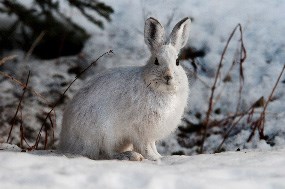
NPS Photo by Tim Rains Moose are not the only species to benefit from fire. The surge in new growth also benefits snowshoe hares. Fire strongly affects the potential for extreme expressions of the snowshoe hare cycle by creating large expanses of prime habitat.
Perhaps more than any other mammal, the snowshoe, or varying hare, demonstrates the remarkable fertility and potential of the northern summer. Hares cycle from scarcity to abundance every decade or so. At the low end of their cycle, there might be only 20 to 40 hares per square mile in prime habitat; in peak years, in the same habitat, the number may rise to 4,000 or more. (The record estimate: 8,900 per square mile in Alberta.) On the upswing of the cycle, hares can breed three, rarely four, times a summer, producing as many as nine leverets (as baby hares are called) per litter. Females can mate on the same day they give birth so that litters might be spaced apart only by a hare’s 36-day gestation period. The flood of hares benefits predators of all kinds but especially lynx, goshawks, and great horned owls.
Some observers thought we had reached the peak of the latest hare cycle in 2007. Instead of a sharp decline, however, the population continued to expand for another year, or more. On one evening drive from the Toklat River to Highway Pass, I counted 110 hares by or in the road. They literally were everywhere.
The peak cycle, at least by my estimation, came in late 2009. In the aftermath, huge swaths of terrain from Igloo Creek to west of the Toklat River looked as if a mowing machine had trimmed the woody plants at snowline, others down to ground level. Many plants were entirely girdled and killed. In the wake of three consecutive winters of over-browsing, areas in Sable Pass that once were densely shrub-covered were now open fields of dead sticks. Prior to the peak, a standing moose could have easily hidden in those mature thickets that now could scarcely hide a fox. Instead of fire, absent in this particular area for decades, abundant hares accomplished large scale alteration of the dominant plant community.
After the peak, snowshoe hares seemed to vanish overnight. The explanation for the rapid decline from the peak of the cycle to the bottom, scientists tell us, is a complex of predation, disease, parasitism, and nutritional stress. The crash phase of the cycle, in my understanding, is initiated when the hares destroy their preferred winter food, the twigs and bark of willows, poplars, and other plants. A more complete explanation includes the response of woody plants to over-browsing. Woody plants respond to severe browsing by producing toxic substances repellent to herbivores. In short, plants produce their own chemical defense mechanisms.
Black spruce and alder have high concentrations of toxic resins that hares and moose avoid. I learned this when I first came to Denali in the 1960’s and tried to understand why some plants, like willows, were eagerly pruned off by moose, while other plants, like dwarf birch, went untouched. I even picked off pieces of birch to taste the bitter resin.
This most recent hare cycle is the fourth that I have witnessed in Denali and Interior Alaska. I have seen high numbers of hares, and the resulting browse damage, on the Delta River, on the Koyukuk and Wood Rivers, but never in Denali to this extreme. I do recall some severe, localized over-browsing along the Nenana River in the early 1990's but nothing widespread. We do know that weather fluctuations can impact hare cycles. Perhaps, just perhaps, the recent relatively mild winter weather played a part in allowing hare numbers to cycle so high, and persist so long, culminating with the over-browsing and habitat alteration so obvious to even casual viewers.
Even before I came to Alaska I was enthralled by the wondrous cycle of hares: Abundance beyond count. Animals that turn the color of snow. Golden-eyed wild cats concealed in the thickets. Owls attacking on silent wings. Squirrels and weasels, wolves and grizzlies, all gnawing the bones of reluctant prey. Hares and moose competing for the same browse. The ravaged, but recovering, willows in the wake of it all. A finer example of the dynamics of the northern food chain, enabled by healthy plant communities, would be hard to find. 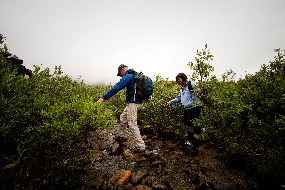
NPS Photo by Nathan Kostegian Over the years I’ve trained myself to notice the small things—like this year’s late bloom and scarcity of pasque flowers, the near-absence of fireweed blossoms, the emergence of willow catkins in late March—all indicators of a trend with troubling consequences. I read these little signs and am left reeling, concerned for the future of an ecosystem that took centuries to establish. Are we on, or beyond, the red line of climate change? Is there anything to be done about it? In Denali we have wilderness protection, and isolation, as buffers against some threats but we are not immune to the reshaping of the great weather.
Climate change is nothing new; it marks the earth’s epochs. Long-dominant plants and animals replaced by other species responding to altered conditions. Winners and losers. Already plants, insects, and animals thrive where they have never lived before, replacing long-established species struggling with change. What is new, according to most all scientific analysis, is the speed with which the earth is warming, reliance on fossil fuels the likely culprit. The world is turning hot, stormy, and unpredictable. Only time will tell the ultimate winners and losers in Denali’s interplay of plants and animals.
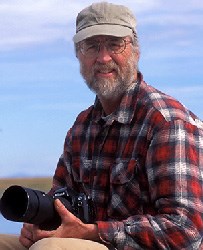
In the 48 years that Tom Walker has lived in Alaska, he has worked as a conservation officer, wilderness guide, wildlife technician, log home builder, documentary film advisor, and adjunct professor of journalism at the Homer Branch, University of Alaska, Anchorage. A full-time freelance writer and photographer specializing in natural history and wildlife, he is regarded as one of Alaska's premier nature photographers. In 2013, the Alaska Historical Society named him "Historian of the Year" for the Seventymile Kid, his biography of Harry Karstens, the first superintendent of Denali (then Mount McKinley) National Park. A two-volume history of the park region, McKinley Station: People of the Pioneer Park and Kantishna: Mushers Miners and Mountaineers, is a culmination of 30 years of research.
|
Last updated: March 29, 2017
